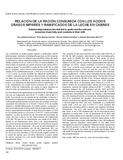Relación de la Ración consumida con los Ácidos Grasos Impares y Ramificados de la Leche en Cabras
Fecha
2017-05Palabras Clave
Grasa láctea, Aceite vegetal, AnálisisMetadatos
Mostrar el registro completo del ítemResumen
Los contenidos en ácidos grasos impares y ramificados (AGIR) determinados mediante cromatografía gaseosa en 94 muestras de grasa láctea (GL) se utilizaron para identificar el tipo de ración consumida por cabras mediante análisis discriminante lineal. Las dietas consistieron en un control (CON), sin aceite añadido, y la misma dieta enriquecida con aceite de girasol alto oleico (GAO), aceite de girasol normal (GN) o aceite de lino (LIN). De un total de 21 variables, cuatro fueron seleccionadas como predictores válidos (C7:0, metiltetradecanoato, C15:0 iso y la suma de C17:0 + C17:1 cis-9). La prueba de Wilks fue altamente significativa (P < 0,001), indicando que el análisis discriminante era aplicable a los datos del presente estudio. La primera función discriminante canónica explicó el 90,9% de la varianza observada entre los grupos. Las distancias de Mahalanobis entre el tratamiento CON y los tratamientos con aceite fueron similares (5,1 a 6,6; P < 0,001). Entre los tratamientos con aceite, la mayor distancia se observó entre los tratamientos GN y GAO (0,95; P < 0,05).
No hubo diferencias significativas en las distancias del tratamiento LIN con los tratamiento GAO (0,27; P = 0,58) y GN (0,48; P = 0,28). De acuerdo con los valores de los centroides, la función 1 discriminó el tratamiento CON de los tratamientos con aceite. Los coeficientes estandarizados indicaron que las variables con mayor capacidad discriminante en la función 1 fueron C7:0 en sentido negativo y metiltetradecanoato en sentido positivo. La función 2 discriminó débilmente al tratamiento GN del tratamiento GAO. La mayor capacidad discriminante en esta función se debió a C15:0 iso en sentido positivo y a la suma C17:0+C17:1 cis-9 en sentido negativo. La tasa de acierto de las funciones discriminantes de Fisher fue muy superior en las observaciones del tratamiento CON (82,1%) que en los tratamientos con aceite (31,8; 50,0 y 40,9% en los tratamientos GAO, GN y LIN, respectivamente). Las observaciones del tratamiento GAO se confundieron en gran medida con las del tratamiento LIN, y las de este tratamiento se confundieron principalmente con las del tratamiento GN. Los resultados obtenidos indicaron que los AGIR de la grasa láctea GL no sirven para identificar el tipo de aceite vegetal incluido en la ración de cabras, pero permiten diferenciar la grasa láctea GL de las raciones con y sin aceite añadido mediante análisis discriminante lineal.
Colecciones
Información Adicional
| Otros Títulos | Relationship between the diet fed to goats and the odd and branched chain fatty acid contents in their milk |
| ISSN | 0798-2259 |
| ISSN Electrónico | 2477-944X |
| Resumen en otro Idioma | The contents of odd and branched chain fatty acids (OBCFA) in 94 milk fat (MF) samples, determined by gas chromatography, were used to identify the diet fed to dairy goats by linear discriminant analysis. The diets consisted on a control without added oil (CON), and the same diet supplemented with high oleic sunflower oil (OSO), regular sunflower oil (RSO) or linseed oil (LO). Four variables were selected as valid predictors (C7:0, methylltetradecanoate, C15:0 iso and the sum of C17:0 plus C17:1 cis-9) out of 21 OBCFA identified in milk fat. Wilk’s test was highly significant (P < 0.001), which indicated that the data were appropriate for a linear discriminant analysis. The first discriminant function accounted for 90.9% of the variance between groups. Mahalanobis squared distances between the CON treatment and the other three oil treatments were similar (5.1 to 6.6, P < 0.001). Within the oil supplemented rations, the RSO and OSO treatments showed the highest distance (0.95, P < 0.05). The distances between the LIN treatment and the OSO and RSO treatments were not significant (0.27, P = 0.58, and 0.48, P = 0.28, respectively). According to the centroids, function 1 discriminated the CON treatment from the oil treatments. Methyltetradecanoate and C7:0 presented the greatest discriminant ability in this function in positive and negative directions, respectively. Function 2 discriminated the RSO and OSO treatments in a weakened mode, with C15:0 iso and C17:0+C17:1 cis-9 showing the greatest discriminating ability in positive and negative directions, respectively. The error rate count of the Fisher’s functions was lower in the CON treatment (82.1% of observations were classified correctly) than in the oil treatments (31.8, 50.0 and 40.9% of observations were classified correctly in the OSO, RSO and LIN treatments, respectively). Individual observations in the OSO treatment were mainly misclassified in the LIN treatment, whereas several individual observations of the latter were misclassified in the RSO treatment. Obtained results indicate that the OBCFA content in milk fat MF does not predict the type of plant oil fed to goats, but allows an accurate classification of the milk fat MF from goats fed a diet with or without added oil by linear discriminant analysis. |
| Colación | 142-148 |
| País | Venezuela |
| Institución | Universidad del Zulia (LUZ) Universidad de Los Andes (ULA) |
| Publicación Electrónica | Revista Científica |
| Sección | Universidad de Los Andes (ULA) |






